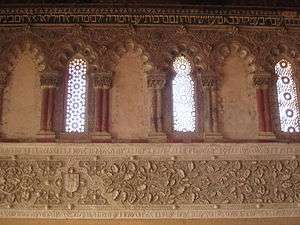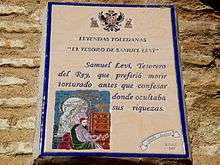Synagogue of El Transito

The Synagogue of El Transito (Spanish: Sinagoga del Tránsito), once also known as the "Synagogue Samuel ha-Levi" (Spanish sinagoga de Samuel ha-Leví) is a historic building in Toledo, Spain. It is famous for its rich stucco decoration, which bears comparison with the Alcazar of Seville and the Alhambra palaces in Granada.
History of building
It was founded as a synagogue by Samuel ha-Levi Abulafia, Treasurer to Peter of Castile, in about 1356. The founder was a member of a family that had served the Castilian kings for several generations and included kabbalists and Torah scholars such as Meir and Todros Abulafia, and another Todros Abulafia who was one of the last poets to write in the Arab-influenced style favored by Jewish poets in twelfth and thirteenth-century Spain. King Peter probably gave his assent to the building of the synagogue to compensate the Jews of Toledo for destruction that had occurred in 1348, during anti-Jewish riots that accompanied the arrival of the Black Death in Toledo. The founder eventually fell foul of the king and was executed in 1360. The synagogue was converted to a church after the expulsion of the Jews from Spain. The building, which is in a good state of conservation for its age, is currently a museum.
History of changes
After the expulsion of the city's Jews under the Alhambra decree in 1492, the Synagogue came under the Order of Calatrava, who converted the building into a church serving a priory dedicated to Saint Benedict, In the 17th century the church's name changed to Nuestra Señora del Transito: the name derives from a painting by Juan Correa de Vivar, Transit of the Virgin.
The synagogue was also used as military headquarters during the Napoleonic Wars.
In 1877 the building became a national monument.
The transformation of the building into the Sephardi Museum, as it is now officially called, started around 1910. It was initiated by the Veca-Inclan foundation.
Architecture
This Synagogue was the private family synagogue of the king's wealthy treasurer, Don Samuel ha-Levi Abulafia.
With the apparent approval of the king, he defied all the laws about synagogues being smaller and lower than churches, and plain of decoration. It features Nasrid-style polychrome stucco-work, Hebrew inscriptions praising the king and himself, and quotations from the Psalms, as well as multifoil arches and a massive Mudéjar panelled ceiling. Arabic inscriptions are intertwined with the floral patterns in the stucco pane.
Women's Gallery
Women were separated from men during the ceremonies, but were allowed to watch.
The Gallery is located on the first floor of the southern wall, having five open windows looking down towards Aron Kodesh or (to use more correct Sephardi terminology) the Hechal.
Elchurches
 El Transito
El Transito Samuel ha-Levi
Samuel ha-Levi Holy Ark
Holy Ark Mosaic
Mosaic Detail on the east wall
Detail on the east wall Detail of the roof & wall
Detail of the roof & wall Interior
Interior Interior
Interior View towards ceiling
View towards ceiling Torah Ark cover
Torah Ark cover View from Women's Gallery
View from Women's Gallery Tallit
Tallit

 Jewelry
Jewelry
External links
- (Spanish) Official Website
| Wikimedia Commons has media related to Sinagoga del Transito. |
Coordinates: 39°51′21″N 4°01′46″W / 39.8557°N 4.02944°W